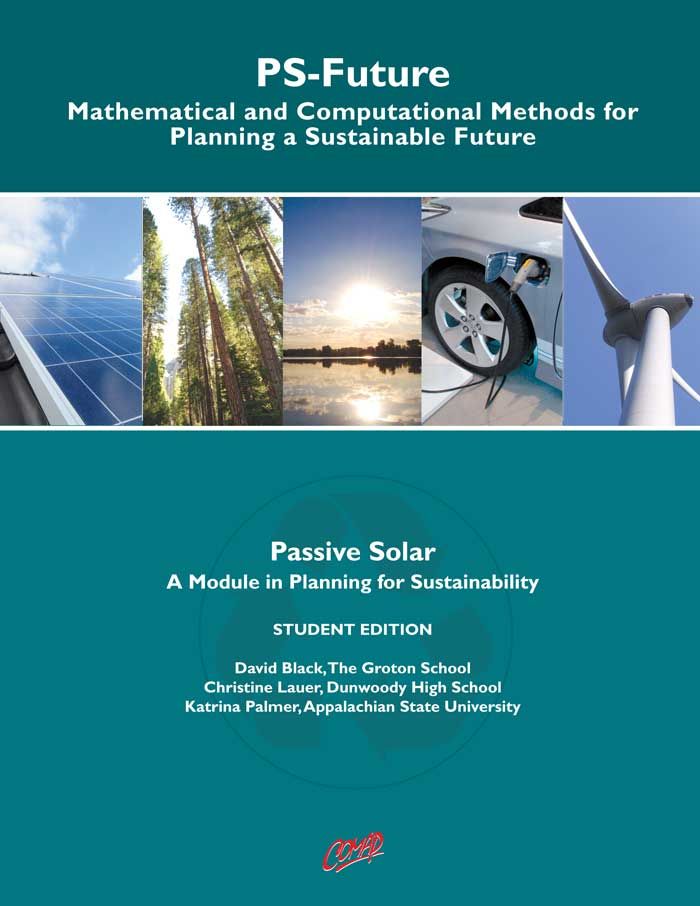
PS-Future
Mathematical and Computational Methods for Planning a Sustainable Future
About the PS-Future project and its modules
The PS-Future project is a collaboration led by Rutgers University involving the Center for Discrete Mathematics and Theoretical Computer Science (DIMACS), the School of Environmental and Biological Sciences, and Heldrich Center for Workforce Development at Rutgers University; the Consortium for Mathematics and its Applications (COMAP); Colorado State University; the Groton School; Hobart and William Smith Colleges; and a number of authors and educators from around the country.
The modules are intended to provide 4-6 days of classroom activities on a variety of topics that apply computational and mathematical methods in sustainability. Each module links to Common Core State Standards (CCSS) in Mathematics and targets content for a particular mathematics course. Each module also addresses disciplinary core concepts required by the Next Generation Science Standards (NGSS), especially targeting concepts taught in Environmental Science and Biology courses. The modules are also particularly suited to address Practice Standards for both mathematics and science.
Each module contains examples of jobs related to the module topic, together with a discussion of the skills and training required, as well as information on the salary and future demand for such jobs. In many cases, specific job titles are mentioned within the modules.
Modules
Engages students in designing energy-efficient buildings using right-triangle trigonometry. Students learn about the seasonal change in the angle of elevation of the sun and how it can be used to let in or keep out the sun for energy efficiency. They also experiment with different materials to observe their heat absorption properties.
Historically water has been taken for granted, especially in humid areas like the southeastern United States. This module uses math concepts of estimation and dimensional analysis to understand the discharge rate of water and total volume of runoff. Using geometry concepts of volume and area, students will explore what it really means to get one inch of rain and how it differs between various terrains. Students will calculate runoff and determine where the water goes and the effects it has on the environment.
Introduces students to “weather generators” for simulating weather data, such as future precipitation in various locations. Students learn about the concept of statistical persistence in weather and the critical link between weather, the water cycle, and global sustainability.
Going Batty: Modeling White Nose Syndrome in Bats
Examines the many important roles that bats play in the ecosystem and how they are now threatened by White Nose Syndrome (WNS). The module introduces the SIR (Susceptible, Infected, Removed) model to study WNS. Students learn about the effect of diminished bat populations on ecosystems and humans, and they use spreadsheet-based simulations to model disease progression and explore the effect of proposed strategies for combatting the disease.
Looks at the ecological impact of both plant and animal invasive species. Students learn about how an invasive population grows and spreads across a geographic landscape, and they do quantitative assessments and simulations using different rules for population growth and spatial spread. Students model strategies for controlling the spread of an invasive species and discuss why some succeed while others do not.
Applying Game Theory to the Sustainable Use of Water (And Other Natural Resources) Water Games uses concepts drawn from mathematical game theory to model competition for water and other scarce resources and to examine potential strategies available to parties in conflict. Students use game theory to predict outcomes based on play of a game and to change outcomes by changing associated payoffs.
Not in My Backyard explores how to consider social and environmental justice when making decisions like where to put a toxic waste dump. Often such facilities are located in economically depressed areas, based on priorities that further disadvantage those who are already disadvantaged.
Sustainability is forward-looking, and natural resources are finite. Planning for sustainability therefore involves making decisions about how we use limited resources in light of the continuing future needs for those resources. Planning for sustainability seeks to identify practices that can continue indefinitely without critically damaging natural resources, people, or economies, especially those that are at risk. While it is tempting (and simpler) to base decisions purely on their immediate economic impacts, doing so can easily overlook the long-term environmental (and social) consequences that can undermine sustainability. In planning for sustainability, it is important to consider that human economic and social systems exist within and are dependent on the environment. Decision makers need to identify how their choices impact both human and environmental systems, as well as whether such choices could persist indefinitely into the future.
Ecosystem Services: The Multiple Values of a Forest
Immerses students in making decisions on forest resource management. The module introduces students to sampling methods to assess forest resources and potential timber values, while also considering the value of ecosystem services like erosion prevention, carbon sequestration, and habitat provision. It illustrates that sustainable management of a natural ecosystem requires a full accounting of all effects of an action--both direct and indirect--over time.
Introduces basic concepts in the use of geographic information systems (GIS) to explore patterns of greenhouse gas (GHG) emissions both across and within US cities, as well as changes over time. Students also map heat in both urban and rural areas and consider links with land use and GHG emissions.

This material is based in part upon work supported by the National Science Foundation under Grant Number DRL-1503414 DRL-1220022(past). Any opinions, findings, and conclusions or recommendations expressed in this material are those of the author(s) and do not necessarily reflect the views of the National Science Foundation.